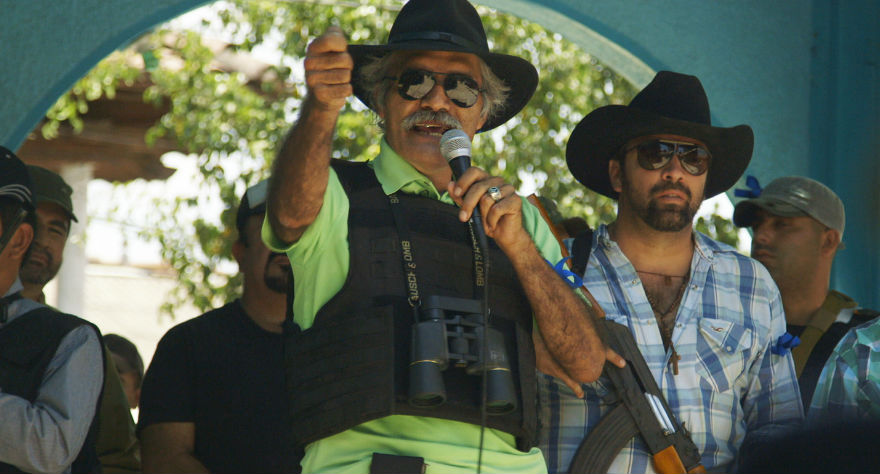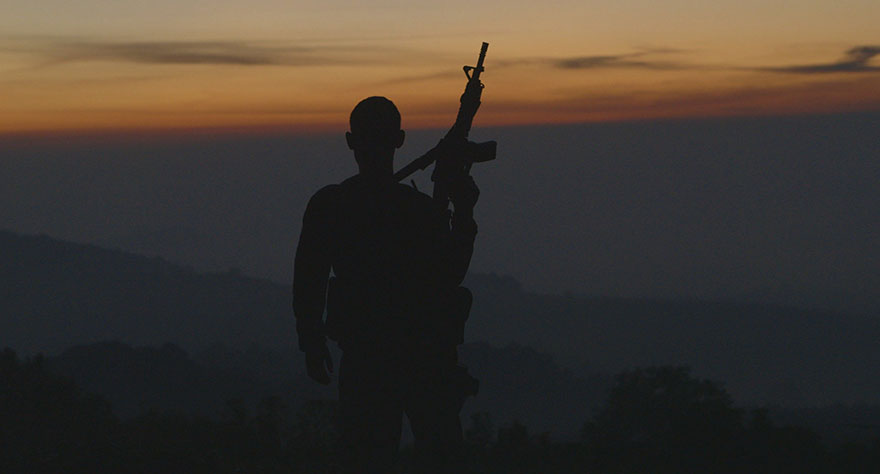Matthew Heineman Talks ‘Cartel Land,’ Filming in the Belly of the Beast

Taking us into the eye of a storm of vigilante warfare, Matthew Heineman’s Cartel Land is a thrilling, layered documentary steeped in danger and serpentine street politics. Warring factions in the Mexican state of Michuacán have taken the lives of innocents and filled the streets with unlicensed armaments in their crossfire: drug cartels like the Knights Templar have terrorized the people for years, while the white T-shirt-wearing Autodefensas, led by Dr. Jose Mireles, have fought to protect the civilians, though their methods are as illegal as their drug-trafficking opposition.
Heineman and his small crew dive straight into the street wars of Mexico as well as take a look at the life of Tim Foley, an American leading a group called Arizona Border Recon, who’ve devoted their lives to protecting U.S. borders from the drugs and bloodshed ravaging Mexico. It’s an intimate portrait that explores the politics motivations of all parties, even those in the cartel. The film is packed with jaw-dropping revelations that reveal the true nature of the conflict raging just beyond our borders.
I spoke to Matthew about his experience making Cartel Land, which is out in limited release now.

Have audiences’ reaction to the film been what you anticipated, or were you surprised?
I generally don’t try to spend too much time anticipating exactly how an audience is going to react. I tried to make a film that moved me. Hopefully people latch onto it. I’m really grateful for the response we’ve gotten.
The movie really makes your mind move a mile a minute. Lots of stuff to ponder, lots of questions to consider.
One of the things I wanted to do was let the story tell itself, especially on the Mexican side. I originally thought I was telling this very simple hero/villain story. Guys in white shirts fighting against guys in black shirts. Slowly, over time, I realized the line between good and evil is much more blurry. The story evolved in a way I never could have imagined or predicted. I’m not a war reporter. I’ve never been in situations like this before. I could never have imagined I’d be in shootouts between vigilantes and the cartel.
Is the way the story plays out in the film the way you experienced it?
Yeah, totally. That was one of my goals in editing the film, to allow the audience to go on the same journey I went on. All those moments when I felt the rug was pulled out from under me; all those moments when I thought I understood what was happening, but things changed. I wanted the audience to go through those same emotions, go on that same roller coaster.
How long did it take to shoot?
About a year. We first started filming in Arizona, and after about four or five months, my father actually sent me an article about the Autodefensas, having no idea I’d actually follow through on it. Right when I read it, I knew I wanted to create this parallel narrative about vigilanteism on both sides of the border. Two weeks later, I was filming in Mexico. I spent about nine months in Mexico, on and off. About one or two weeks in Mexico every month.
The subjects in your film are larger than life. Do you think living a life under threat of death breeds richer personalities?
I don’t know. I didn’t want to make a simplistic film. I didn’t want to make a film with an agenda. I really wanted to let the story dictate where I would go. I didn’t want to put nice, neat boxes around the characters or the movements. I wanted to be comfortable in exploring these murky, murky waters we were filming in. There were many times, especially near the end of the film, when I’d be on a mission in the back of a truck, I truly didn’t know if they were the good guys or the bad guys. That was a scary, scary thing.
Did that mess with your head?
Yeah. It was unlike anything I’d ever done before. It definitely had a personal impact on me. It solidified in my mind how I view life and how I want to live my life. Have an open mind. I’ve been criticized for not having a stronger point of view. But in my opinion, the film does have a very strong point of view. Just because I don’t have talking heads or experts or stats putting things into context for people doesn’t mean the film doesn’t have a powerful voice. Making the film reinforced my desire to look at things with an open mind. A mentor of mine in the film world said, “If you end up with the story you started with, you weren’t listening along the way.” I listened every day as I went through this complicated moral quagmire of a journey.
Unlike a lot of other docs that might cover this material, I think your movie conveys what the situation in Mexico and on the border feels like rather than what it looks like on paper.
My goal was to take this issue out of the headlines. It’s glorified by TV shows and in headlines, and I wanted to get beyond that and put my camera right in the middle of the action. Put myself right in the middle of the action. That’s what I tried to do, not from the outside, but from the middle of it.
What was the vision for the aesthetics of the film?
Aesthetics were really important to me. I wanted to mask the intensity of what we were seeing with the way we shot it. It was very important.
I’ve been enjoying this influx of documentaries that are very cinematic and utilize visual storytelling as opposed to talking heads. It’s a great time for docs.
Yeah, it’s an incredibly exciting time to be making documentary films. The technology has been democratized by cheaper cameras and cheaper ways of making film. The outlets have expanded: there are more and more places to show your film. That’s really, really exciting. I think documentary films generate powerful conversations and show people a world they’ve never seen before. I feel incredibly grateful and honored that I can do this for a living and tell stories.
You put yourself in a lot of danger for this movie. What drives you as a filmmaker?
What an amazing thing to be able to spend time with people and have them open up their lives to me. To travel around the world and tell people stories. It’s a privilege, it’s an honor and something I take very seriously. I fell in love with Mexico and the people of Michoacán, and I felt a great duty and obligation to tell this complicated story. I’m really glad with how it turned out.
